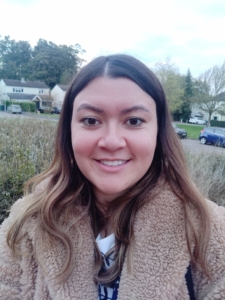Looking back at Cranfield as an Alumna
29/04/2022

 Grace Harland is a Cranfield alumna from Hertfordshire and studied a BSc in Geography at the University of Leeds. A year after graduation, she enrolled at Cranfield University to study Environmental Water Management MSc (now called Advanced Water Management MSc)
Grace Harland is a Cranfield alumna from Hertfordshire and studied a BSc in Geography at the University of Leeds. A year after graduation, she enrolled at Cranfield University to study Environmental Water Management MSc (now called Advanced Water Management MSc)
Why did you decide to pursue a postgraduate course?
I made the decision to pursue a postgraduate course during my time working as an Intern for Waterwise. I wanted to further my understanding in the field of Environmental Water Management and gain transferable skills which I could apply in my future career.
Why did you choose this postgraduate course and institution?
During my year of employment after completing my undergraduate degree, I received several recommendations from others who had attended the same course at Cranfield University. The insight I gained from discussions with them, and further research led me to choose the Environmental Water Management course at Cranfield. I was particularly interested in undertaking the group project, which other universities did not seem to offer an equivalent of, and the links with industry that this offered.
Did you take up further study immediately after your first degree? If not, what did you do? Please list any employment/travel/voluntary work you had.
After completing my degree at the University of Leeds, I worked for 9 months. I was offered a 3-month research assistant post at the University of Leeds. The role progressed the research I had undertaken for my dissertation. I then worked as an Intern for Waterwise for 6 months.
Please tell me a little bit about the course and what it involves, including details of your individual Master’s project.
The course was split up into modules, a group project and an individual thesis project. Each module lasted two weeks with the first week dedicated to teaching and the second week spent undertaking the module assessment. This format worked well as you could focus on one topic at a time. The group project followed the modules and lasted for approximately 3 months. There were a number of projects that we could choose between, and they were offered to students across three different courses, providing an opportunity to collaborate with other students on the other watercourses at Cranfield. The outputs of the project were a report and a poster presentation which were provided to the client. My individual project was on climate change modelling. This involved producing a number of greenhouse gas emission scenarios and assessing the future impact of the agriculture and forestry sector.
What have you done since you graduated e.g., job/further study/travel?
I have been working at Affinity Water as an Asset Scientist in the Water Resources & Environment team. The MSc was an important step forward in my career and helped me secure my role at Affinity Water.
What was the highlight of your Master’s degree?
My highlight was undertaking the group project. I was in a group with seven others from my course and we completed a project on diffuse pollution for Natural England, which included a field trip to Norfolk to collect the data for our report. As a group we analysed, interpreted and made recommendations from the data we had collected to produce the report. At the end of the project, we were tasked to produce a poster and present the findings. We also had the opportunity to present the key findings to the client. Throughout the project duration, I drew upon and improved on a number of transferable skills.
What tips would you give to others choosing a Masters’s degree?
Dedicate time to exploring a variety of Master’s courses and attend the open days so you can gauge whether the course is likely to be the right fit for you. I would advise using LinkedIn and other platforms to network with former students and students looking into further study. You might even come across a course or university that you had not previously considered.
Categories & Tags:
Leave a comment on this post:
You might also like…
Keren Tuv: My Cranfield experience studying Renewable Energy
Hello, my name is Keren, I am from London, UK, and I am studying Renewable Energy MSc. My journey to discovering Cranfield University began when I first decided to return to academia to pursue ...
3D Metal Manufacturing in space: A look into the future
David Rico Sierra, Research Fellow in Additive Manufacturing, was recently involved in an exciting project to manufacture parts using 3D printers in space. Here he reflects on his time working with Airbus in Toulouse… ...
A Legacy of Courage: From India to Britain, Three Generations Find Their Home
My story begins with my grandfather, who plucked up the courage to travel aboard at the age of 22 and start a new life in the UK. I don’t think he would have thought that ...
Cranfield to JLR: mastering mechatronics for a dream career
My name is Jerin Tom, and in 2023 I graduated from Cranfield with an MSc in Automotive Mechatronics. Originally from India, I've always been fascinated by the world of automobiles. Why Cranfield and the ...
Bringing the vision of advanced air mobility closer to reality
Experts at Cranfield University led by Professor Antonios Tsourdos, Head of the Autonomous and Cyber-Physical Systems Centre, are part of the Air Mobility Ecosystem Consortium (AMEC), which aims to demonstrate the commercial and operational ...
Using grey literature in your research: A short guide
As you research and write your thesis, you might come across, or be looking for, ‘grey literature’. This is quite simply material that is either unpublished, or published but not in a commercial form. Types ...






